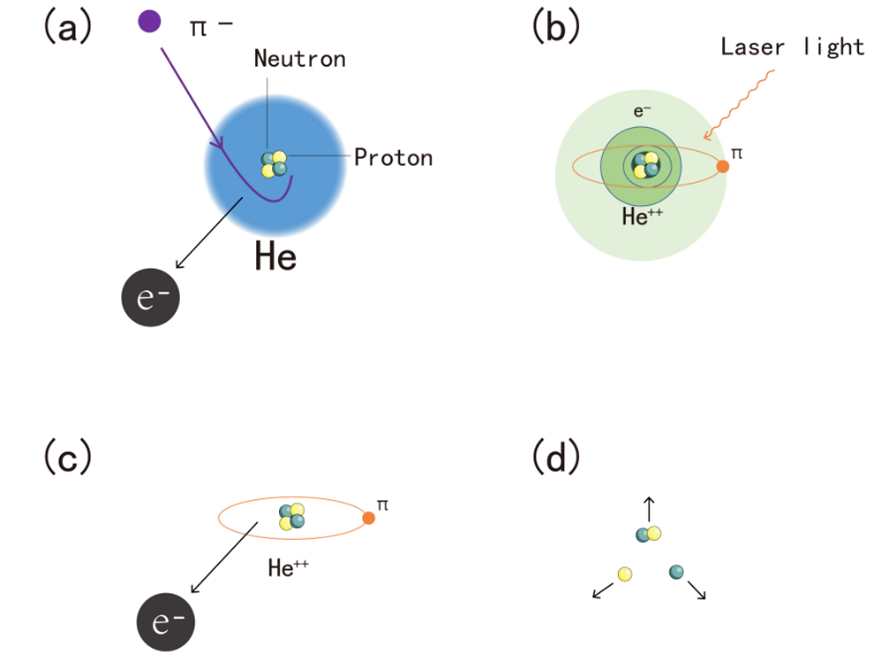Researchers at the Chinese Academy of Sciences’ Innovation Academy for Precision Measurement Science and Technology (APM) recently calculated the exotic atom π4He+ (17,16)→(16,15) transition frequency. This result is now the most precise in the world, with an accuracy of 4 parts per billion (ppb).
 First Laser measurement for exotic atom pion helium. Image Credit: Innovation Academy for Precision Measurement Science and Technology.
First Laser measurement for exotic atom pion helium. Image Credit: Innovation Academy for Precision Measurement Science and Technology.
By integrating current precision measurements at the Paul Scherrer Institute (PSI) in Switzerland, this effort will enhance the precision of pion mass by 2–3 orders of magnitude. Using the π+ decay experiment, the precision of neutrino mass will be enhanced by two orders of magnitude, providing important information for the neutrino mass problem.
Physical Review Letters published the relevant findings.
In 1935, Japanese physicist Yukawa Hideki (Nobel Prize in Physics 1949) predicted the existence of pion, which was later proven by British physicist Cecil Frank Powell in 1957. Pion refers to any of the three subatomic particles π0, π- and π+.
Pions are the lightest mesons (and, most generally, hadrons) with spin 0, with masses of around 273 times that of an electron. They are unstable, with the charged pions π- and π+ decaying with a mean lifespan of 26 nanoseconds (2.6E-8 seconds), making pion mass measurement challenges.
In the same year that Powell discovered pions in cosmic rays, American physicist Enrico Fermi predicted the creation of exotic atoms by substituting π- for electron. These exotic atoms have the π- in a distinct orbit, which allows laser technology to analyze its features. PSI features a 1.3 MW proton ring cyclotron that can produce a high flux π- beam for pion helium spectroscopy.
When the π- beam collides with the helium gas, π- will take place one of two electrons locked in metastable orbits in helium will be released. As these orbits are distant from the nucleus, the π- may withstand nuclear capture in tens of nanoseconds, making the laser spectroscopic experiment feasible. Finally, the other electron is released, and π- decays to lower orbits before being captured by the nucleus, leading to nuclear fission resulting neutron, proton and deuteron.
More evidence has recently emerged suggesting that the standard model of particle physics should be modified. The behavior of µ and W bosons in pion decay differs from what the standard model predicts (SM). Fermilab discovered on April 7th, 2021, that the anomalous magneton of µ deviates by 4.2 sigma from the SM theory estimate.
Fermilab revealed a year later that the W boson mass had been measured to a value that differed by 7 sigma from the SM prediction. This data highlights the significance of pion research.
Currently, the pion mass is measured to a precision of 1E-6 using the X-Ray technique. It demonstrates that pion helium spectroscopy has the potential to enhance the precision of the pion mass. The π- in helium capture experiment can be traced 60 years back. Until recently, the existence of metastable pion helium was confirmed by PSI laser spectroscopic experiment. They detected the frequency of π4He+ (17,16)→(17,15).
Even while this experimental accuracy cannot be utilized to enhance pion mass, it was a promising start. They intend to quantify the narrow (17,16)→(16,15) transition, maybe up to the 1E-9 level. It is important to theoretically compute the transition of (17,16)→(16,15) in order to accomplish the target of pion mass.
The π4He+ (17,16)→(16,15) transition frequency was calculated by APM researchers using their own complex coordinate rotation method based on the gradient optimization (CCR-GO) method, which included leading order relativistic and radiative corrections (R∞α2 and R∞α3 orders), as well as R∞α4 and R∞α5 orders of corrections. As a result, the theoretical transition prediction has been improved to 4 ppb (4E-9).
The National Natural Science Foundation of China, the CAS Strategic Priority Research Program, and the CAS President’s International Fellowship Initiative all contributed to this research.
Journal Reference:
Bai, Z-D., et al. (2022) Precision Spectroscopy of the Pionic Helium-4. Physical Review Letters. doi.org/10.1103/PhysRevLett.128.183001.